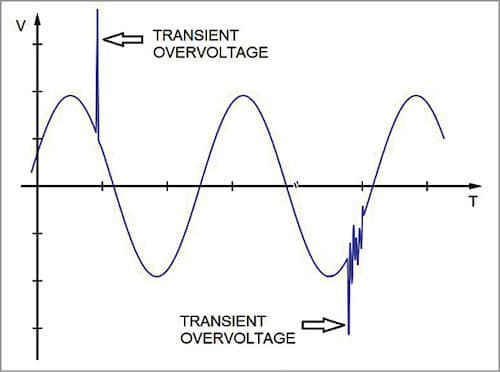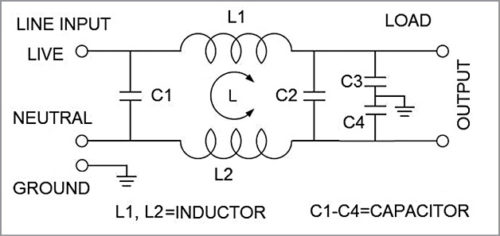A surge protector or surge suppressor is a device designed to protect electrical devices from undesirable sudden and short-term increase in voltage spike. Both voltage surge and voltage spike referring to short-term increase in voltage look similar but are different.
While a voltage spike is a sudden increase in voltage lasting less than three nanoseconds, a voltage surge is a sudden increase in voltage that lasts for three nanoseconds or more.
A voltage spike or surge is basically a transient overvoltage or electrical impulse of short duration but high energy, which is induced into the circuit from external sources. Transient overvoltage in AC power is shown in Fig. 1.

Common sources of voltage spikes and surges include electrical switches, lightning and static electricity. Voltage spikes may also be created by a rapid build up or decay of a magnetic field, which may induce energy into the associated circuit. For example, if current flowing through a relay coil is interrupted or de-energised, the inductor produces a high-frequency voltage spike.
The most common solution is to place a rectifier diode across the relay coil (inductor). The diode is referred to as a freewheeling, suppressor or fly-back diode. When current is interrupted, it provides a return path for the current, so that current flow through the inductor is not blocked. Current dissipates over time through its internal resistance, and heat is generated by the inductor and the rectifier.
Both voltage spike and surge phenomena can be disruptive to electrical equipment, and cause considerable damage.
There are different types of surge and spike protection devices available in the market. Surge protection devices (SPDs) and transient voltage suppressors (TVSes) are normally installed in power distribution systems, heavy-duty industrial systems and communication systems, to protect against voltage surges and spikes.
Power-line filter
A power-line filter is an electronic filter placed between an electrical device and a line external to it. It is a passive, bi-directional network that filters a particular frequency in the power line or circuit.
A line filter is designed for electromagnetic interference (EMI) in AC mains, and usually consists of inductor, capacitor and resistor. It reduces ripples in output voltage as much as possible. Some power-line filters provide minimal voltage regulation, while others protect against power-quality problems.
A typical passive network power-line filter schematic is shown in Fig.2. The network is suitable for both AC and DC power with bi-directional suppression capability.

Design of surge protection
A simple surge protection is essentially a metal oxide varistor (MOV) across the input line of an electrical equipment—generally a single component only in some equipment. This can either be an MOV or a TVS diode. For universal 90V AC – 264V AC line, usual MOV voltage rating is 300V rms.
However, in case of expensive equipment and high surge expectation, such as from the power line, it is necessary to refer to the safety standard ratings and guidelines, such as IEC 61000-4-5, which define the standards for AC power-line surges.
While designing the circuit, varistor voltage value should include at least 20 per cent safety margin. For example, for a 25V DC system, the varistor should be rated at around 30V. However, it is important not to exaggerate the margin, to avoid a large varistor and a higher clamping voltage. Also, the surge protection device must be mounted next to the fuse.
For more details on surge protection and guidelines, refer to the following links:






